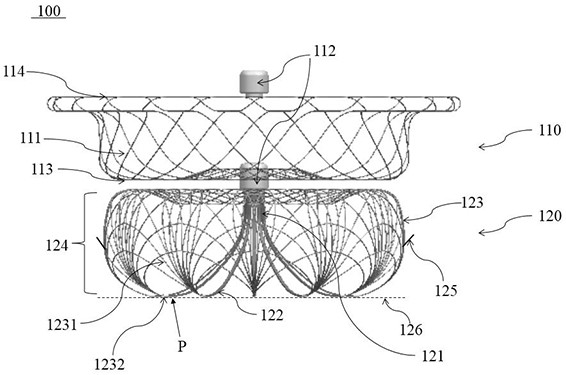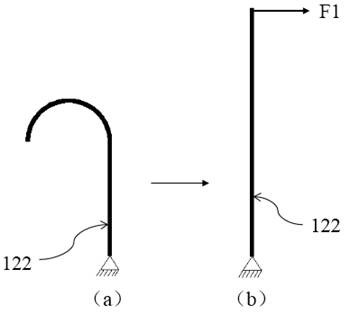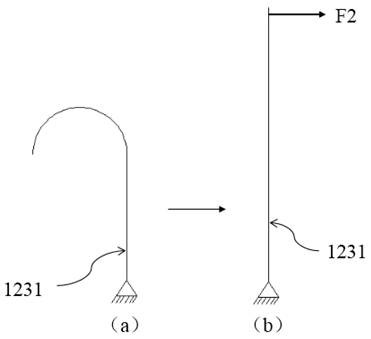Occlusion device
A sealing device and sealing part technology, which is applied in medical science, surgery, etc., can solve the problem of weak turning ability of the fixed disk, and achieve remarkable and improved effects
- Summary
- Abstract
- Description
- Claims
- Application Information
AI Technical Summary
Problems solved by technology
Method used
Image
Examples
Embodiment 1
[0031] The occlusion device proposed in Example 1 can be used to occlude the left atrial appendage, and can also be used to occlude other tissues in the body with openings, such as atrial septal defect. In the following, the closure device will be described in detail by taking the closure of the left atrial appendage as an example.
[0032] Please refer to figure 1 , the occlusion device 100 includes a sealing portion 110 and a fixing portion 120 connected to the sealing portion 110 . The sealing portion 110 and the fixing portion 120 are arranged at intervals along the axial direction of the occluding device 100 . The sealing part 110 is located at the proximal end of the occluding device 100 , and the fixing part 120 is located at the distal end of the occluding device 100 . The occlusion device 100 has a compressed state contained in the sheath for delivery in the body, and protrudes outward from the distal end of the sheath and self-expands and expands as shown in FIG. ...
Embodiment 2
[0044] The occlusion device 200 of Embodiment 2 is generally similar to the occlusion device 100 of Embodiment 1, and the same features thereof will not be repeated here. The main difference between Example 2 and Example 1 is that, as Figure 5 As shown, the proximal end of the supporting mesh 223 is closed, and the first braided wire 1231 at the proximal end of the supporting mesh 223 is spread out radially from the main end portion 121 and stretches for a certain distance toward the distal end, and then outwards toward the sealing portion 110 Turn over, then continue to extend a certain distance towards the direction of the sealing part 110, and finally, the distal end of the supporting net 223 is bent towards the inside of the fixing part 120, so as to prevent the end of the supporting net 223 from abutting against the cavity of the left atrial appendage after the fixing part 220 is deployed wear on the wall. The proximal end of the support net 223 can be closed and fixed ...
Embodiment 3
[0049] The blocking device 300 of the third embodiment is generally similar to the blocking device 100 of the first embodiment and the blocking device 200 of the second embodiment, and the same features thereof will not be repeated here. The main difference between embodiment 3 and embodiment 1, embodiment 2 is that, as Image 6 As shown, the fixing part 320 includes a main end part 121 located at its proximal end and a lead-out section 326 connected to a distal end of the main end part 121 . The lead-out section 326 is braided by the third braided wire 3261 to form a mesh tube with a hollow interior and openings at both ends. The proximal end is closed and fixed by the main end portion 121, and the distal end is fixedly connected to a plurality of flipping rods 122 respectively. The connection method can be: Welding, bonding, socketing through sleeves, etc.
[0050] The distal end of the lead-out section 326 is open, and the distal edge is fixedly connected with the support ...
PUM
 Login to View More
Login to View More Abstract
Description
Claims
Application Information
 Login to View More
Login to View More - R&D
- Intellectual Property
- Life Sciences
- Materials
- Tech Scout
- Unparalleled Data Quality
- Higher Quality Content
- 60% Fewer Hallucinations
Browse by: Latest US Patents, China's latest patents, Technical Efficacy Thesaurus, Application Domain, Technology Topic, Popular Technical Reports.
© 2025 PatSnap. All rights reserved.Legal|Privacy policy|Modern Slavery Act Transparency Statement|Sitemap|About US| Contact US: help@patsnap.com



